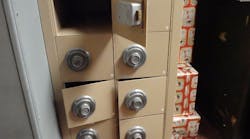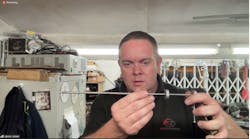The C23 Cannon Series gun safe has a 12- gauge body and a 1.5” thick double steel composite door. This UL residential security container has an Intertek ETL 60-minute/1200-degree F fire protection rating. In addition to the fire barrier panels within the safe, it comes with a triple fin intumescent cold smoke expandable seal and a heat0 activated door seal that expands when exposed to heat.
The silver mist gun safe is equipped with top and side boltwork, operated by a three-spoke handle. One-inch diameter active locking bolts secure the door from opening when locked. When unlocked, the door swings open on Truelock internal hinges.
For protection against unauthorized entry, an anti-punch relocking mechanism incorporates a plate screwed on to the surface of the mechanical lock. Yes, a mechanical combination lock!
The customer who was interested in purchasing this safe liked everything about it from the color of the interior to the configuration of the rack and number of shelves. However, the couple had difficulty dialing the combination and asked if there was an alternative. The salesperson explained how the electronic safe lock operates by entering a single series of numbers instead of turning the dial in different directions, while having to line up the specific numbers. If any one of the combination numbers is passed, you must start over.
I had just received a sample LpLOCKS electronic safe lock, Model EL-20 and keypad KBL-10-MC. This lock was designed and patented by Nick Gartner of NL Lock Technology, founder of La Gard, Inc.
A short discussion with the salesperson concluded in giving me permission to retrofit the LpLOCKS electronic safe lock onto the C23 Cannon Series Safe. LpLOCKS’ electronic safe locks are similar dimensions as the mechanical locks, having the mounting hole dimensions interchangeable with the mechanical locks.
The EL-20 Electronic Lock has a UL Type 1, VdS Class 2 and an EN 1300 Class B certifications. The EL-20 is also known as the RotoBolt safe lock, named for the movement of the bolt as the lock becomes unlocked or locked. The bolt rotates in one direction, arcing from the open (retracted) position to the locked (extended) position. The RotoBolt safe lock can be installed in all four of the mounting directions. The RotoBolt case is non-handed, permitting the lock to be installed cover plate up or cover plate down in order to accommodate left or right hand applications.
The RotoBolt is operated using a six-digit code or a word with six letters. There is a Manager (Main) Code and an optional User (secondary) Code. Typically the safe manufacturer keeps the manager code on file as a security backup and the customer will only have the one User code.
When purchasing the lock from a wholesaler, only the Manager code is provided and the additional User code must be programmed into the lock. The Manager Code can activate and delete the User Code. When a valid code is entered, a double beeps sounds. The lock electronically retracts the block function for three seconds, permitting the bolt to be moved by the boltwork unlocking the safe. When the boltwork is moved to the locked position, the RotoBolt automatically secures the bolt. When an invalid entry occurs, there is a long beep. When entering a code, if no key is pressed within ten seconds, a started code entry is cancelled.
Note: There is no override code. The Managers Code or User Code (if programmed) must be known in order to operate the electronic safe lock.
To prevent manipulation, a time out provides significant protection. If four consecutive wrong codes are entered, a five- minute keypad lockout activates. During the lockout, the LED flashes every ten seconds and any key press causes a long beep. After the five minutes, two more invalid code entries restart the five-minute lockout.
LpLOCKS also offers a time delay function electronic safe lock, the EL-25. This keypad programmable time delay is from one to 99 minutes, and any of their keypads can be used with this model lock.
Along with the EL-20, I was given an LpLOCKS KBL-10-MC keypad. The KBL-10 has a telephone style keypad (0-9, * and #) using a pressure-sensitive membrane for the keys. An LED is at the left between the 4 and 7. The keypad has a sliding door along the bottom to accommodate a 9 Volt battery used to power the keypad and the lock.
RETROFITTING THE LOCK
Retrofitting an electronic safe lock onto a safe is not difficult as most compatible safe locks mechanical and electronic have similar dimensions regarding mounting holes and operation, position and size of the bolt.
The one variation between most mechanical safe locks and electronic safe locks is the mounting locations for the dial ring/keypad. Most mechanical safe dial rings mount onto the two vertical threaded holes above and below the spindle hole. Most electronic safe lock keypads mount using two horizontal screw holes, one on each side of the spindle hole. A problem can result if the safe manufacturer does not drill the two horizontal holes in the safe door.
The RotoBolt’s case footprint is interchangeable with standard mechanical safe locks. To simplify matters, the RotoBolt case is non-handed, permitting the lock to be installed cover plate up or cover plate down. There are even screw holes on the side opposite the cover to permit the installation of an anti-punch relock using self-tapping screws.
Retrofitting the LpLOCKS RotoBolt onto a Cannon Series Model 23 is relatively simple. Start by removing the fire barrier panel covered with upholstery from the inside of the door. The panel slides into a track at the bottom. Two holes beneath the track permit lifting the panel in order to gain access to the boltwork and lock. Use two nut drivers from beneath the door to lift the panel. Once the panel has been lifted above the lip, tilting out the nut drivers enables the panel to be removed.
With the fire barrier panel in a safe place, remove the mechanical safe lock cover, the dial with spindle, the dial ring and the safe lock itself. Be careful to remove the relock. It is important to keep the door open and locked once the mechanical safe lock has been removed and when installing the electronic safe lock. Accidentally closing the door in this condition could result in the relock triggering and the door being locked.
The next step is to carefully de-burr the spindle hole to avoid damage to the cable. The Cannon Series 23 safe’s spindle hole diameter is approximately 3/8”, a size sufficient for the RotoBolt cable connector. The KBL-10 cable is just under 12”, more than sufficient length for this retrofit.
Because all Cannon Safes have two vertical and two horizontal holes drilled into the door to accommodate mounting the mechanical lock dial ring or electronic lock keypad, we only had to thread the horizontal holes using an 8-32 tap to accommodate the keypad mounting screws.
If there were no horizontal holes, we would have two choices. First, we could drill and tap the two horizontal holes in the safe door. Second, LpLOCKS has an optional keypad mounting adapter plate #MA-1which eliminates the need to size, drill, and tap the horizontal holes. The adapter provides the two threaded horizontal mounting holes. The bracket is screwed into the two vertical mounting holes and the keypad is installed onto the two shoulder screws, (provided with the lock) mounted horizontally.
Note: If no horizontal holes are already in place, and the drilling option is chosen, use a #29 drill bit to drill the holes.
The next step is to run the cable through the spindle hole and mount the RotoBolt safe lock onto the door. Make sure the direction of the lock bolt will unlock the boltwork. Mount the lock using the three supplied Phillips Head screws, being careful to position the cable in order to plug the connector into the lock. Once the lock has been mounted, attach the relock using either the cover screw holes or the screw holes in the rear of the lock case, and the provided longer screws. Make sure the relock is in the proper position.
The next step is to connect the cable to the RotoBolt. If there are two connectors on the safe lock, the one located closest to the outer edge of the lock case is for the keypad (ENT). The other is for an additional internal battery (BAT) option.
The final step is to mount the two keypad shouldered mounting screws horizontally on the face of the door and install the keypad. The keypad has two mounting slots, position the keypad above the two screws and gently snap downward into place. The battery door is along the bottom of the keypad.
Important: The keypad can be removed from the mounting screws by providing a solid rap to the bottom edge of the keypad using the palm of your hand. Do not hit the keypad using a mallet.
Slide open the battery door, attach the battery to the connector and slide the battery into the bottom of the keypad. Carefully slide the battery door closed. The electronic safe lock has been installed.
With the door open, rotate the three spoke handle to the locked position. The active bolts in the safe door should extend, and the RotoBolt bolt should slide through the opening of the boltwork to lock the boltwork from retracting.
PROGRAMMING
The next series of steps tests the operation and programs the new Manager Code and User Code. The default Manager Code is 1, 2, 3, 4, 5, 6. The lock should emit a double beep when the correct code has been entered. Turn the three spoke handle to rotate the boltwork to the unlocked position. Do not close the door.
Note: Always keep the door open when testing the operation of the lock or changing the combination.
The next series of steps is to program a new Manager Code and if desired, a User Code.
To program a new Manager code:
Step 1. Press and hold the “0” key until the keypad sounds a double beep. The LED will illuminate and remain illuminated until programming is completed.
Step 2. Enter the existing six-digit Manager Code. Double beep sounds.
Step 3. Enter the new six-digit Manager Code. Double beep sounds.
Step 4. Re-enter the new six-digit Manager code. Double beep sounds.
If the re-entry is not the same, a single long beep sounds and the old Manager code remains valid.
To program a User code:
Step 1. Press and hold the “1” key, (which has the letter “A” for ADD), until the keypad sounds a double beep. The LED will illuminate and remain illuminated until programming is completed.
Step 2. Enter the six-digit Manager Code. Double beep sounds.
Step 3. Enter the new six-digit User Code. Double beep sounds.
Step 4. Re-enter the new six-digit User code. Double beep sounds.
To delete the User Code:
Step 1. Press and hold the “3” key, (which has the letter “E” for ERASE) until the keypad sounds a double beep. The LED will illuminate and remain illuminated until programming is completed.
Step 2. Enter the six-digit Manager Code.
Step 3. The User is erased, and the LED will go out.
INTERNAL DIAGNOSTICS
The LpLOCKS RotoBolt has been designed with a unique internal diagnostic feature enabling problems with the keypad or lock to be identified using key presses.
To start the diagnostics, press the “5” key until the LED illuminates and the keypad beeps. Press the “1”key. If a double beep sounds, it indicates the key and the system are operable. If there is a problem with the “1” button or a communication problem between the keypad circuit board and the lock circuit board, one loud beep will sound and the LED will extinguish, ending the diagnostics. If the system is operable, press the “2” key. A double beep indicates the key is operable. Continue to press each number through “0” to make sure each key is operable. If a key is not operational, one loud beep will sound and the LED will extinguish ending the diagnostics.
If the diagnostics ends when the “1” key is pressed, try attaching a different keypad to test the “1” key function.
Since the EL-20 is dimensionally similar to the standard mechanical combination safe lock, retrofitting is relatively simple as existing protection (relock) can easily be mounted to properly positioned screw holes.
LpLOCKS recommends replacing the 9 Volt Duracell™ or Eveready™ alkaline batteries annually. When the battery is weak, pressing a key results in five beeps. Replace the battery.
For more information contact your lock wholesale supplier or the safe manufacturer directly. Don’t forget that when servicing a safe, you should first determine if it is still under the manufacturer’s warranty before proceeding with the service. Ask the customer if he or she has a copy of a completed warranty card or call the safe manufacturer for assistance.
For more information, contact LpLOCKS, LLC, 1520 Heartland Way, Corona, CA 92881. Phone: (951) 372-0500. Fax: (951) 372-0910. Web Site www.LpLOCKS.com.





